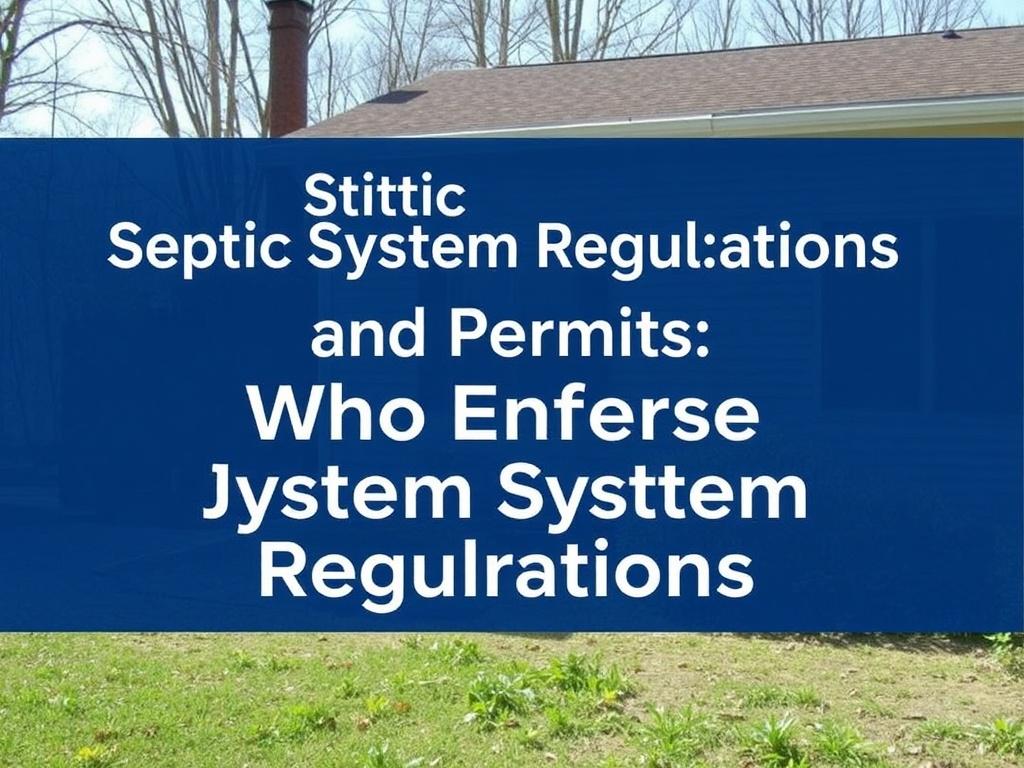Septic systems are an essential part of many homes, especially those located in rural or suburban areas where municipal sewer connections are unavailable. While septic systems offer effective wastewater treatment solutions, they are also subject to a variety of regulations and permits to ensure they function properly and protect public health and the environment. If you’re a homeowner considering installing, repairing, or maintaining a septic system, understanding septic system regulations and permits is crucial. This article will take you through the necessary steps, rules, and requirements, helping you navigate the often-complex world of septic system compliance.
- What Are Septic Systems and Why Are Regulations Necessary?
- Key Types of Septic System Permits
- Why Each Permit Matters
- Common Septic System Regulations You Should Know
- 1. System Design and Sizing
- 2. Setbacks and Location Restrictions
- 3. Soil Testing and Site Evaluation
- 4. Regular Inspections and Maintenance
- Understanding the Permit Application Process
- Documents Typically Required
- How to Stay Compliant with Septic System Regulations
- Common Violations and How to Avoid Them
- Who Enforces Septic System Regulations?
- How to Find Your Local Regulations
- Innovations and Changes in Septic System Regulations
- Benefits of Staying Updated on Regulations
- Choosing Professionals for Your Septic System Needs
- Questions to Ask Your Contractor
- Common Myths About Septic System Regulations and Permits
- Truths That Should Guide Your Approach
- Conclusion
What Are Septic Systems and Why Are Regulations Necessary?

Before diving into permits and regulations, it’s helpful to understand what a septic system is and why it’s so closely monitored. A septic system is an underground wastewater treatment structure, typically consisting of a septic tank and a drain field. Household wastewater flows into the tank, where solids settle and bacteria break down waste. The liquid then moves into the drain field, where it is gradually filtered by soil layers.
Regulating septic systems is vital because improper management can lead to groundwater contamination, property damage, and health risks like bacterial infections. Regulations help maintain system integrity, protect natural resources, and ensure that sewage treatment meets public safety standards.
Key Types of Septic System Permits
Before installing or making significant changes to a septic system, obtaining the appropriate permits is often mandatory. Different areas may have slightly varied requirements, but the core types of permits usually include the following:
- Building Permits: Needed for new installations or modifications of structures associated with the septic system.
- Septic System Installation Permits: Required to approve the design and location of a new septic system or major repairs.
- Septic Tank Pumping Permits: In some jurisdictions, you may need a permit to have your tank pumped or serviced.
- Operation and Maintenance Permits: Certain areas require permits that ensure ongoing inspections and maintenance of the system.
Why Each Permit Matters
Building permits ensure that the physical installation complies with local construction codes, preventing unsafe or faulty setups. Installation permits are critical because the design must suit the property’s soil type, size, and landscape to function properly. Pumping permits, where required, help keep track of maintenance schedules, preventing system overflows and contamination. Operation and maintenance permits encourage regular system health checks, extending longevity and safety.
Common Septic System Regulations You Should Know
Regulations governing septic systems vary widely depending on state, county, and local governments. However, several common themes run through most regulations:
1. System Design and Sizing
Regulations often specify minimum tank size, drain field dimensions, and appropriate locations based on the size of the household and soil permeability. These specifications ensure the system can adequately treat wastewater.
2. Setbacks and Location Restrictions
There are usually rules about where you can place a septic tank and drain field. These setbacks include minimum distances from wells, water bodies, property lines, buildings, and even roads to prevent contamination and ensure safety.
3. Soil Testing and Site Evaluation
Before installation, soil tests are often mandatory. Percolation tests assess how quickly water drains through the soil, indicating if the location is suitable for a septic system.
4. Regular Inspections and Maintenance
Some regulations require periodic inspections to check for leaks, system failures, and environmental risks. Failure to maintain a septic system can lead to fines or forced repairs.
Understanding the Permit Application Process
Applying for septic system permits usually involves several important steps, each requiring careful attention:
- Site Assessment: A licensed professional or local health department evaluates the site for suitability, including soil and water conditions.
- System Design Submission: Submit engineering plans or approved system designs for local authority review.
- Application Form: Complete a permit application detailing property information, system type, and ownership.
- Fee Payment: Pay applicable fees, which vary depending on location and scope of work.
- Inspection Scheduling: Arrange inspections during and after installation to ensure compliance.
Documents Typically Required
| Document | Description |
|---|---|
| Site Evaluation Report | Results of soil tests and percolation rates. |
| System Design Plan | Detailed drawings showing tank and drain field layout. |
| Property Ownership Proof | Deed or title documents proving property ownership. |
| Application Form | Completed by the property owner or contractor. |
| Payment Receipt | Proof of fee payment for permit processing. |
How to Stay Compliant with Septic System Regulations
Compliance with septic system regulations is not just about obtaining permits. It involves ongoing responsibilities to ensure your system operates effectively and safely:
- Schedule Regular Pumping: Most systems require pumping every 3 to 5 years, depending on usage and tank size.
- Avoid Harmful Chemicals: Avoid flushing harsh chemicals or non-biodegradable items that could damage bacteria essential for waste breakdown.
- Protect the Drain Field: Do not park vehicles, build structures, or plant deep-rooted trees over drain fields, as this could cause damage.
- Recordkeeping: Keep detailed records of inspections, pumping, repairs, and permits to prove compliance if required.
- Notify Authorities of Changes: Inform local health departments of system repairs, upgrades, or changes in property use.
Common Violations and How to Avoid Them
Some frequent violations include neglecting inspections, illegal system modifications, poor maintenance, and failure to obtain permits before installation or repair. Awareness, planning, and working closely with licensed professionals can help avoid costly fines and system failures.
Who Enforces Septic System Regulations?

Regulations come from multiple layers of government, with enforcement typically handled by local health departments, environmental agencies, and building code officials. These bodies conduct inspections, investigate complaints, issue permits, and impose fines or remediation orders for violations. Additionally, some states offer guidance and support programs to help homeowners maintain compliant septic systems.
How to Find Your Local Regulations
Since septic regulations vary widely by location, it’s important to consult the relevant authorities before you act. Here are some practical ways to find the information you need:
- Visit your local county or city health department website.
- Contact the environmental protection agency for your state.
- Speak with licensed septic system contractors familiar with local codes.
- Check local zoning office requirements related to your property.
Innovations and Changes in Septic System Regulations

As environmental concerns grow and technology advances, septic system regulations continue to evolve. New design standards emphasize eco-friendly systems that better protect groundwater and reduce pollution. In some places, regulations encourage or require septic system upgrades or alternative treatment methods to address aging systems.
For instance, advanced treatment units that provide nitrogen removal or enhanced filtration are gaining traction, and some localities now require these in sensitive areas. Wastewater treatment technologies integrated with septic systems are also becoming more common, responding to stricter water quality standards.
Benefits of Staying Updated on Regulations
Remaining informed about current and emerging septic regulations helps homeowners avoid penalties, improve system performance, and contribute positively to environmental protection. It also ensures better property values and fewer emergencies related to septic system failures.
Choosing Professionals for Your Septic System Needs
Navigating septic system regulations and permits can be complex, and hiring qualified professionals is a wise decision. Licensed septic contractors, engineers, or environmental consultants can aid in:
- Conducting soil tests and site evaluations.
- Creating designs that meet code requirements.
- Submitting permits and documentation properly.
- Performing inspections and maintenance services.
Always verify licenses and reviews before hiring, and consider getting multiple quotes or consulting neighbors about reliable experts in your area.
Questions to Ask Your Contractor
| Question | Purpose |
|---|---|
| Are you licensed and insured? | Guarantees professionalism and liability coverage. |
| Can you handle permit applications? | Ensures they understand regulatory processes. |
| What is your experience with local septic regulations? | Confirms familiarity with area-specific laws. |
| Do you provide warranties or service guarantees? | Protects you from future malfunctions or defects. |
| Can you schedule regular maintenance inspections? | Helps maintain compliance and system health over time. |
Common Myths About Septic System Regulations and Permits
Many homeowners mistakenly believe permits are unnecessary for small repairs, or that septic systems don’t require maintenance until problems appear. Others think regulations are overly burdensome or costly. However, bypassing regulations can end up costing much more due to fines, contamination cleanup, or expensive repairs.
Another myth is that septic systems are “set and forget.” In reality, regular oversight and adherence to regulations are essential for long-term functionality.
Truths That Should Guide Your Approach
- Permits protect both your property and the environment by ensuring proper system design and operation.
- Routine maintenance prevents costly emergencies and extends system lifespan.
- Compliance helps maintain property value and is often required when selling a home.
Conclusion
Navigating septic system regulations and permits might seem overwhelming at first, but understanding the basics equips you to make smarter decisions about wastewater management on your property. From knowing the importance of obtaining the right permits to adhering to design, installation, and maintenance rules, staying informed keeps your septic system running smoothly and safely. Leveraging knowledgeable professionals, staying current with evolving regulations, and committing to regular system care are key to protecting your home, health, and the environment. Whether installing a new system or maintaining an existing one, respect for septic system regulations and permits is the foundation for peace of mind and long-lasting functionality.
Помогла вам статья?






